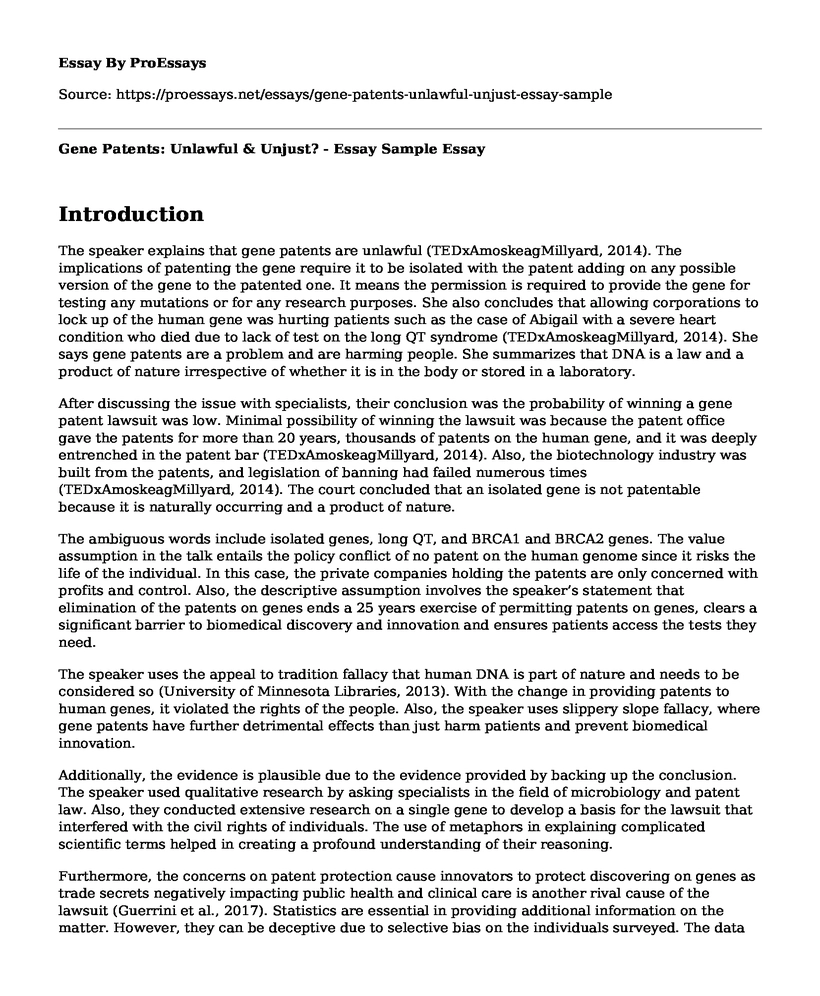Introduction
The speaker explains that gene patents are unlawful (TEDxAmoskeagMillyard, 2014). The implications of patenting the gene require it to be isolated with the patent adding on any possible version of the gene to the patented one. It means the permission is required to provide the gene for testing any mutations or for any research purposes. She also concludes that allowing corporations to lock up of the human gene was hurting patients such as the case of Abigail with a severe heart condition who died due to lack of test on the long QT syndrome (TEDxAmoskeagMillyard, 2014). She says gene patents are a problem and are harming people. She summarizes that DNA is a law and a product of nature irrespective of whether it is in the body or stored in a laboratory.
After discussing the issue with specialists, their conclusion was the probability of winning a gene patent lawsuit was low. Minimal possibility of winning the lawsuit was because the patent office gave the patents for more than 20 years, thousands of patents on the human gene, and it was deeply entrenched in the patent bar (TEDxAmoskeagMillyard, 2014). Also, the biotechnology industry was built from the patents, and legislation of banning had failed numerous times (TEDxAmoskeagMillyard, 2014). The court concluded that an isolated gene is not patentable because it is naturally occurring and a product of nature.
The ambiguous words include isolated genes, long QT, and BRCA1 and BRCA2 genes. The value assumption in the talk entails the policy conflict of no patent on the human genome since it risks the life of the individual. In this case, the private companies holding the patents are only concerned with profits and control. Also, the descriptive assumption involves the speaker’s statement that elimination of the patents on genes ends a 25 years exercise of permitting patents on genes, clears a significant barrier to biomedical discovery and innovation and ensures patients access the tests they need.
The speaker uses the appeal to tradition fallacy that human DNA is part of nature and needs to be considered so (University of Minnesota Libraries, 2013). With the change in providing patents to human genes, it violated the rights of the people. Also, the speaker uses slippery slope fallacy, where gene patents have further detrimental effects than just harm patients and prevent biomedical innovation.
Additionally, the evidence is plausible due to the evidence provided by backing up the conclusion. The speaker used qualitative research by asking specialists in the field of microbiology and patent law. Also, they conducted extensive research on a single gene to develop a basis for the lawsuit that interfered with the civil rights of individuals. The use of metaphors in explaining complicated scientific terms helped in creating a profound understanding of their reasoning.
Furthermore, the concerns on patent protection cause innovators to protect discovering on genes as trade secrets negatively impacting public health and clinical care is another rival cause of the lawsuit (Guerrini et al., 2017). Statistics are essential in providing additional information on the matter. However, they can be deceptive due to selective bias on the individuals surveyed. The data offers a peek on a small sample due to the specific focus on one subject. Basing on the subject of eliminating patents on human DNA, vital information missing is the legal procedure an individual should undertake in canceling a patent on their gene. Also, the implications of going against the patent and providing the gene for testing to a different institution.
References
Guerrini, C. J., McGuire, A. L., Majumder, M. A., Bollinger, J. M., & Rowan, P. J. (2017). Constraints on gene patent protection fuel secrecy concerns: A qualitative study. Journal of Law and the Biosciences, 4(3), 542-564. https://doi.org/10.1093/jlb/lsx034TEDxAmoskeag
Millyard. (2014, November). Tania Simoncelli: Should you be able to patent a human gene? TED: Ideas worth spreading. https://www.ted.com/talks/tania_simoncelli_should_you_behttps://www.ted.com/talks/tania_simoncelli_should_you_be_able_to_patent_a_human_gene_able_to_patent_a_human_gene
University of Minnesota Libraries. (2013). Persuasive Reasoning and Fallacies. Communication in the Real World: An Introduction to Communication Studies.
Cite this page
Gene Patents: Unlawful & Unjust? - Essay Sample. (2023, Aug 21). Retrieved from https://proessays.net/essays/gene-patents-unlawful-unjust-essay-sample
If you are the original author of this essay and no longer wish to have it published on the ProEssays website, please click below to request its removal:
- Can Apes Learn Language?
- Anatomy Essay Example on Human Muscles
- Compare and Contrast Essay on ALF and PETA
- A Discussion on Respiratory System Paper Example
- The Anatomy and Physiology of Lymphatic System
- Essay Sample on Genetic Engineering: Eradicating Sickle Cell Disease?
- Essay Sample on Comparing the Structures and Functions of Reptilian and Mammalian Hearts







